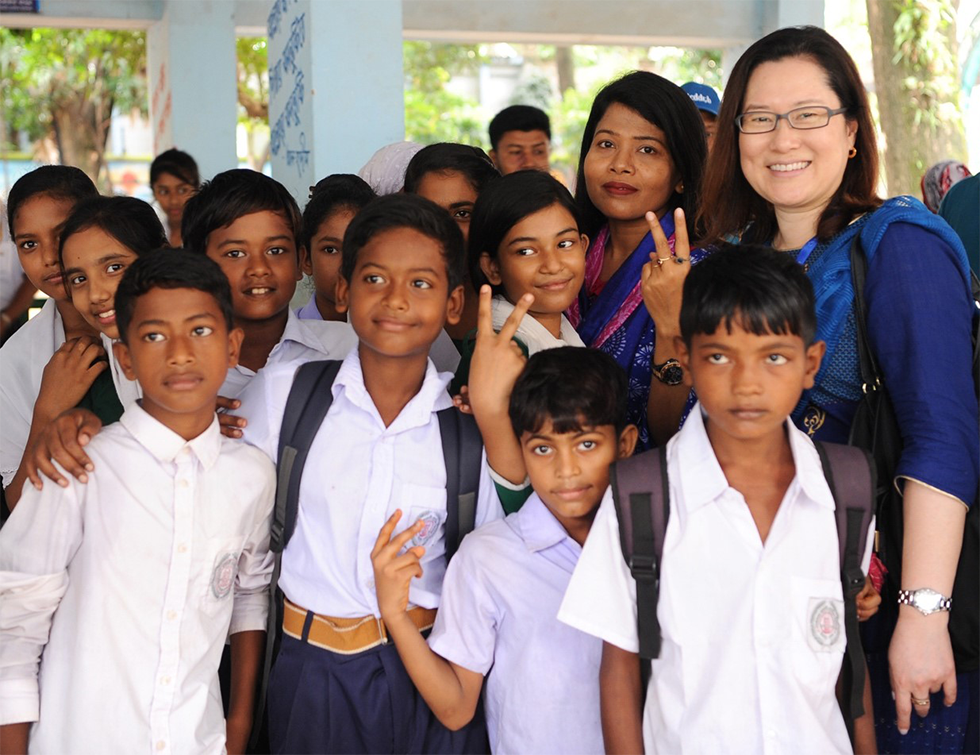
Drs Taniuchi (right) and Mahmuda (center right) with students at a vaccine center located at Jahanabad Government Primary School
On the Road to Eradicating Polio: Finding polio in the environment to supplement acute flaccid poliomyelitis surveillance in resource-challenged countries for the polio endgame.
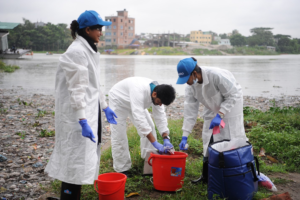
icddr.b researchers collecting sewage water for testing
Mami Taniuchi, PhD, assistant professor in the Division of Infectious Diseases and International Health, has conducted a groundbreaking study funded by the Bill & Melinda Gates Foundation with Infectious Diseases’ Eric Houpt, Bill Petri, and James Platts-Mills. Collaborators also included Rashidul Haque and K. Zaman from the International Centre for Diarrhoeal Disease Research, Bangladesh’s (icddr,b).The study investigated household, community, and environmental transmission of Sabin 2 vaccine strain poliovirus in rural Bangladesh from 2015-2018.The results of this work were published in Lancet Infectious Diseases in Oct 2017 (PMID: 28693854). This current project, which started in 2018 with a $833,000 Gates grant entitled “Validation of TaqMan Array Card (TAC) method for polio environmental surveillance”, ID’s Mami Taniuchi and Suporn Pholwat built on the methods developed in previous studies to develop a novel rapid high-throughput method to track polio transmission in the environment. A secondary goal of this study was to utilize geospacial maps to design an effective environmental surveillance following a vaccine campaign with oral polio vaccine. Collaborators in this new project included Rashidul Haque and Firdausi Qadri from the icddr,b, Isobel Blake and Nick Grassly from Imperial College London, and Sidhartha Giri and Ira Praharaj at the Christian Medical College Vellore in India.
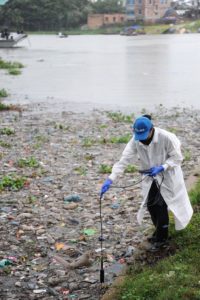
Tahmina Ahmed, research officer, from icddr,b testing the sewage water
In order to achieve a polio-free world, sensitive methods to find poliovirus in its last hiding places are needed. Although acute flaccid paralysis (AFP) surveillance has been the gold standard polio surveillance, this case based system misses poliovirus still circulating in the environment. Thus, the Global Polio Endgame Initiative has expanded environmental surveillance (ES) to supplement the AFP surveillance for the eradication endgame. Current environmental sampling methods are labor intensive, culture based, and can take 14 days for detection of the virus in samples collected from the environment. The environmental TAC assay developed by Taniuchi and Pholwat has several advantages over the conventional method such as it is culture free and only takes 2 days to detection. Additionally, simultaneous detection of 10 different types of polio are possible on this platform.
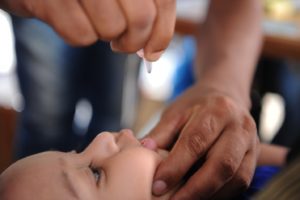
Administering bi-valent oral polio vaccine one drop at a time to children
Dr. Taniuchi’s team validated this new method in the urban slums of Dhaka, Bangladesh and Vellore, India in 2019. Following National Immunization Days (NID) in Vellore, India, we sampled sewage in our study areas using both conventional methods and the novel TAC method. Results showed that PCR-based TAC based detection was as sensitive as the conventional method.
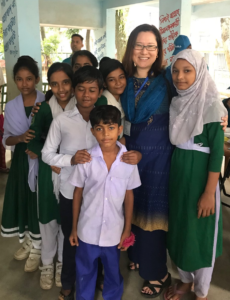
Dr Taniuchi with students at a vaccine center located at an elementary school
In the absence of NIDs in Bangladesh, Dr. Taniuchi’s team conducted specialized immunization activities (SIA) with the polio oral vaccine. The study area included 3 wards of the Mirpur area of Dhaka. For the first 3 months of the study, 50+ field and lab workers gathered household demographic data for the entire study area and traced every small and large sewage line. The main goal was to identify all the children under 5 years of age to vaccinate for the subsequent SIAs. In a collaboration with Novel-T (Geneva, Switzerland) an interactive geospecial map of our study area which included the household and sewage line data was built. This map allowed the team to refine the search for placement of vaccine centers to best capture children under 5 years of age for the SIA and choose environmental sites to detect polio after the SIA. During the special polio vaccine campaign from June 29 to July 8, 2019 the study team vaccinated a total of 18,278 children under 5 years of age. The study is still ongoing and the team is hard at work sampling the sewage for polio virus persistence following the SIA. Initial results are very promising – TAC is successfully detecting Sabin viruses directly from the environment.
Our hope is that this method can be an alternative to the conventional method for environmental surveillance in resource-challenged countries where a reference polio lab is not available to do culture. One of the unique advantages of the environmental surveillance TAC assay is the ability to expand the genes measured to include detection of anti-microbial resistance genes concurrently with the poliovirus in environmental samples. The team owes much gratitude to the amazing teams at CMC Vellore and icddr,b who worked tirelessly to make this study a success!
Filed Under: In the Know, News and Notes, Notable Achievements
